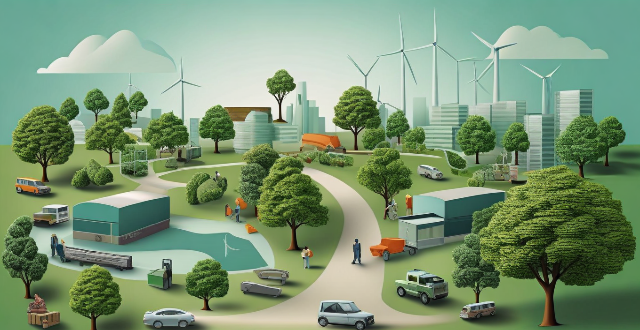Legislation Countries

How does environmental legislation differ across countries ?
Environmental legislation varies across countries due to differences in economic development, political systems, cultural values, and environmental priorities. The legal framework for environmental protection ranges from comprehensive laws covering various issues to piecemeal legislation addressing specific problems. Enforcement mechanisms also differ, with some countries having strong regulatory bodies and others lacking institutional capacity or political will. Penalties and sanctions for non-compliance vary widely, as do opportunities for public participation in decision-making processes. International cooperation is crucial but varies in commitment and action among countries. Overall, these differences highlight the need for greater coordination and cooperation to address global environmental challenges effectively.

Can environmental legislation effectively reduce pollution ?
Environmental legislation has the potential to effectively reduce pollution, but its success depends on various factors such as enforcement and compliance, public awareness and participation, technological innovation, political will, international cooperation, and economic considerations. Strong regulatory bodies, education campaigns, investment in clean technology, government prioritization of environmental protection, global collaboration, and balancing environmental goals with economic development are all crucial for the effectiveness of environmental legislation. Achieving lasting improvements in environmental quality requires ongoing effort from all sectors of society.

How has environmental legislation evolved over time ?
Environmental legislation has evolved over time, reflecting growing awareness of environmental issues. Early stages focused on preserving natural resources and conserving wildlife habitats, while post-World War II saw a shift towards pollution control through air and water quality regulations. The late 20th century introduced comprehensive environmental protection laws addressing multiple aspects of environmental degradation. Today's legislation prioritizes sustainable development and climate change mitigation, with a focus on public participation and transparency in decision-making processes.

How does climate legislation vary across different countries ?
Climate legislation varies across countries due to factors such as government involvement, emphasis on different sectors, stringency of emission targets, and international cooperation. Some countries focus on reducing emissions from transportation or energy production, while others prioritize agriculture or waste management. The level of government involvement also differs, with some countries relying more on local or regional authorities. Additionally, the stringency of emission targets set by different countries varies widely. International cooperation and compliance with global climate agreements also play a role in shaping climate legislation across countries.

What are the economic implications of enacting stringent climate change legislation ?
The article discusses the economic implications of stringent climate change legislation, which include job creation in renewable energy and green infrastructure sectors, potential increases in energy and food prices, new business opportunities in innovation and carbon trading, and investment in clean technology leading to economic growth. However, there are also short-term transition costs and job displacement issues. Despite these challenges, the long-term benefits such as improved air quality and increased resilience against natural disasters make the implementation of such legislation beneficial for future generations.

What challenges have been faced in the adoption and enforcement of climate change legislation ?
Climate change is a global issue that requires immediate attention and action. The adoption and enforcement of climate change legislation are crucial steps in mitigating the effects of climate change. However, several challenges have been faced in this process, including: 1. Lack of Political Will: Governments often prioritize short-term economic gains over long-term environmental sustainability, making it difficult to pass and implement effective climate policies. 2. Economic Barriers: The high cost associated with transitioning to clean energy sources can be a significant barrier to adopting and enforcing climate change legislation. Additionally, the shift towards clean energy can lead to job losses in traditional industries such as fossil fuel extraction and manufacturing. 3. Legal and Institutional Hurdles: Many countries lack comprehensive legal frameworks for addressing climate change, which can hinder the adoption and enforcement of effective climate policies. Weak enforcement mechanisms can also undermine the effectiveness of climate change legislation. 4. Public Awareness and Participation: Public awareness and understanding of climate change issues are essential for the successful adoption and enforcement of climate change legislation. However, many people still lack a basic understanding of the science behind climate change and its potential consequences. Active public participation is crucial for driving change and holding governments accountable for their actions on climate change. Addressing these challenges requires a concerted effort from governments, civil society organizations, businesses, and individuals worldwide. Only by working together can we hope to mitigate the effects of climate change and secure a sustainable future for all.

How does climate change legislation influence corporate sustainability practices ?
Climate change legislation significantly influences corporate sustainability practices by setting standards for environmental responsibility. It compels companies to report on their environmental impact, use market-based mechanisms like cap-and-trade systems, and consider tax incentives or penalties in their operations. This legislation also creates investor pressure through ESG criteria and shareholder resolutions, leading companies to enhance their sustainability practices to meet investor expectations. Additionally, it opens market opportunities for green products and services and encourages renewable energy adoption. Companies that comply with climate legislation can improve their brand image and stakeholder engagement. Furthermore, such legislation aids in risk management by requiring companies to assess physical and transition risks associated with climate change. Overall, climate change legislation is a driving force behind corporations adopting more sustainable practices.

Is cryptocurrency legal in all countries ?
The legality of cryptocurrency varies across countries, withThe legality of cryptocurrency varies across countries, with it and others banning or The United States, Japan, and El Salvador are examples of countries where cryptocurrency is legal and regulated. In contrast, Algeria, Egypt, and Nepal have outright banned it due to concerns over financial stability and potential misuse in illegal activities. China, India, and Russia have imposed restrictions on its use but have not completely prohibited it. It is crucial to understand local laws and regulations before engaging in any cryptocurrency-related activities.

Are there any international efforts to harmonize climate change legislation across different countries ?
International efforts are underway to harmonize climate change legislation across different countries, including the United Nations Framework Convention on Climate Change (UNFCCC), International Emissions Trading Association (IETA), Carbon Pricing Leadership Coalition (CPLC), and Global Green Growth Institute (GGGI). These initiatives aim to create a unified approach to addressing the global challenges posed by climate change through regular meetings, national communications, emissions trading standards, carbon pricing policies, and green growth strategies.

What role do citizens play in shaping environmental legislation ?
The text discusses the significant role that citizens play in shaping environmental legislation. It outlines various ways in which they can influence such legislation, including advocacy and public awareness, voting and elections, lobbying and policy influence, litigation and legal action, and grassroots movements and direct action. The text emphasizes that by working together, citizens can help create a more sustainable future for themselves and future generations.

How effective has the recent climate change legislation been in reducing greenhouse gas emissions ?
The effectiveness of recent climate change legislation in reducing greenhouse gas emissions has been variable, with some regions and policies showing significant success while others face numerous barriers.

In what ways can developing countries participate effectively in global climate governance ?
**How Developing Countries Can Effectively Participate in Global Climate Governance** Developing countries are pivotal in global climate governance due to their disproportionate impact from climate change. Their effective participation can be achieved through several strategies: 1. **Capacity Building**: This involves enhancing educational programs to raise climate awareness and training local experts. It also includes investing in sustainable infrastructure and establishing research institutions. 2. **Policy Integration**: Countries should enact climate-related legislation, set emission reduction targets, and ensure policy alignment across different sectors while engaging stakeholders. 3. **Finance and Investment**: Access international and domestic funds for climate action, and make smart investments in renewable energy and sustainable agriculture. 4. **Technology Transfer and Innovation**: Developing countries should form technology partnerships, create exchange platforms, and encourage local innovation through R&D and incentives. 5. **Participation in International Negotiations**: They should prepare well for negotiations, build coalitions, advocate for their interests, and use forums for dialogue at international conferences. Through these strategies, developing countries can not only protect themselves but also significantly contribute to the global fight against climate change.

How do biosafety policies differ across countries and regions ?
Biosafety policies are crucial for protecting public health and the environment from potential risks associated with biotechnology. These policies vary significantly across countries and regions due to differences in regulatory frameworks, cultural values, economic resources, and technological advancements. The United States has a well-established regulatory framework for biosafety, while the European Union has a strict regulatory framework. In Asia, China and India have relatively new biosafety laws. Cultural values also play a significant role in shaping biosafety policies across countries and regions. Economic resources can impact the implementation and enforcement of biosafety policies, and technological advancements can introduce new challenges and opportunities.

What are the challenges in implementing environmental legislation ?
The text discusses the challenges in implementing environmental legislation, including lack of awareness and education, insufficient funding and resources, political will and support, legal and administrative hurdles, technological limitations, and international cooperation and coordination. Addressing these challenges requires a multi-faceted approach involving education, advocacy, policy reform, and collaboration at all levels of society.

What impact does climate change legislation have on renewable energy development ?
Climate change legislation significantly influences renewable energy development by providing financial incentives, establishing mandated targets, supporting research and infrastructure, creating consumer awareness, fostering international cooperation, implementing regulations, setting environmental standards, and promoting economic growth through job creation. These measures collectively drive the energy sector towards sustainability and a low-carbon future.

What are the key provisions of the latest climate change legislation ?
The latest climate change legislation is a comprehensive package of measures aimed at addressing the challenges posed by global warming and climate change. The key provisions include reduction of greenhouse gas emissions, adaptation to climate change impacts, international cooperation and leadership, just transition for workers and communities, and transparency and accountability.

How do European countries handle asylum seekers and refugees under their immigration policies ?
The handling of asylum seekers and refugees in European countries is guided by international law, particularly the 1951 Refugee Convention and its 1967 Protocol. Each country has its own asylum laws and reception conditions, but they generally follow the principles set out by the EU Asylum Procedures Directive. Asylum seekers must go through a process known as refugee status determination (RSD) to assess whether they meet the criteria for refugee status under the Refugee Convention. Reception centers house asylum seekers while their application is processed, and many countries provide them with access to healthcare, education, and language training. Employment and education opportunities for asylum seekers vary by country, and some may have restrictions on their freedom of movement until their application is decided. Successful integration is a key goal for many European countries, and programs are often in place to help refugees learn the language and understand local culture. However, some countries face challenges due to limited capacity to accommodate large numbers of asylum seekers, leading to overcrowding in reception centers and delays in processing applications. Public opinion towards asylum seekers and refugees varies widely across Europe, and anti-immigration sentiment can influence policy decisions and create obstacles for integration. Examples of European countries' approaches include Germany's comprehensive immigration and asylum system, Sweden's reputation for being welcoming to refugees, Greece's challenges due to its geographical location as a primary entry point for refugees, and Hungary's hardline approach to immigration.

What are some successful examples of legislation that have improved women's rights ?
The text discusses various successful legislations that have improved women's rights over the years. These include granting women the right to vote, prohibiting gender-based wage discrimination, protecting pregnant women in the workplace, providing funding for services for victims of domestic violence, improving women's health care access and coverage, protecting pregnant workers from dismissal or reduced pay during their pregnancy and after childbirth, and eliminating discrimination against women in all areas of life.

How do countries measure their progress towards achieving climate goals ?
Countries measure their progress towards achieving climate goals through various indicators and metrics. These include Nationally Determined Contributions (NDCs), greenhouse gas inventories, renewable energy production, carbon intensity, forest cover and land use changes, climate finance flows, policy implementation, and public awareness and participation. By tracking these factors, countries can assess their performance in reducing emissions, adapting to climate impacts, and supporting global efforts to combat climate change.

Does immigration policy contribute to brain drain in certain countries ?
Immigration policy can contribute to brain drain by offering attractive programs for skilled workers and students, providing better economic opportunities and living conditions, and catering to social and cultural factors. This results in a loss of talent for source countries but can also lead to brain circulation if individuals return with valuable skills.

What role do developing countries play in climate governance ?
The article discusses the crucial role of developing countries in climate governance, highlighting their vulnerability to climate change, growing greenhouse gas emissions, active participation in international negotiations, innovation and technology transfer, financing and investment needs, and capacity building requirements. It emphasizes that developing countries are essential for achieving a successful outcome in the global fight against climate change.

What countries have successfully implemented a carbon tax ?
Countries that have successfully implemented a carbon tax include Canada, Sweden, Finland, Norway, Switzerland, and the UK. These countries have set different rates for their carbon taxes and have seen varying degrees of success in reducing greenhouse gas emissions. While there are challenges associated with implementing such a tax, these countries demonstrate that it can be an effective tool for achieving environmental goals.

How can we ensure compliance with environmental legislation ?
Ensuring compliance with environmental legislation is crucial for protecting the planet and its inhabitants, and can be achieved through education and training of stakeholders, developing and implementing policies, monitoring and reporting performance, and collaborating with stakeholders.

What is the impact of environmental legislation on businesses ?
This article discusses the impact of environmental legislation on businesses, including cost implications, reputation and brand image, innovation and competitive advantage, and legal risks and liability. It highlights the need for businesses to comply with these laws and regulations to avoid negative consequences and position themselves as leaders in sustainability and innovation.

How does climate vulnerability differ across regions and countries ?
Climate vulnerability varies significantly across regions and countries due to geographical, socio-economic, infrastructure, governance, and cultural factors. Coastal areas are more vulnerable to rising sea levels, while inland areas face challenges related to droughts and heatwaves. Developed nations have more resources for adaptation, while developing nations often lack the financial and technical capacity. Urban areas might have better access to resources but can suffer from heat island effects, while rural areas could be impacted by changes in agricultural productivity. Areas with robust infrastructure and advanced technologies are less vulnerable, while those lacking these face higher risks. Stable governments can develop long-term climate policies, while unstable regions might lack the continuity needed for effective climate action. Communities with strong social networks and high levels of education about climate change are more likely to engage in adaptive behaviors. Addressing climate vulnerability requires tailored approaches that consider each area's unique circumstances and needs.

What role do scientists play in shaping climate change legislation ?
Scientists play a crucial role in shaping climate change legislation by providing evidence-based research, influencing policy development, and educating the public and raising awareness about the issue. Their expertise helps policymakers understand the severity and potential consequences of climate change, identify patterns and predict future scenarios, assess impacts on ecosystems and human health, advise on effective strategies for addressing climate change, testify before government bodies, participate in public forums and debates, publish scientific papers and reports, collaborate with media outlets, and participate in educational programs and workshops.

What challenges do countries face in implementing circular economy policies ?
Implementing circular economy policies is a complex process that countries face numerous challenges. These include lack of awareness and understanding, economic and industrial structure, legal and regulatory framework, market conditions and business practices, as well as social and cultural factors. Addressing these challenges is crucial for the successful implementation of circular economy policies, which can bring significant environmental and socioeconomic benefits.

What are some innovative examples of climate adaptation in developing countries ?
Climate adaptation is becoming increasingly important for developing countries, which often lack the resources to cope with the impacts of climate change. However, these countries are also finding innovative ways to adapt to changing environmental conditions. Here are some examples: 1. Integrated Watershed Management 2. Climate-Smart Agriculture 3. Ecosystem-Based Adaptation 4. Urban Green Infrastructure 5. Community-Based Adaptation

How do international teacher training standards compare across different countries ?
This text is about the differences in teacher training standards across countries. It explains that while there are some common elements to most teacher training programs, such as foundational education and practical experience, there are also significant differences due to factors like cultural influences and funding. The text then goes on to describe these differences in more detail.

What are the key components of environmental legislation ?
The article discusses the key components of environmental legislation, which are designed to protect the environment and promote sustainable development. These include Environmental Impact Assessment (EIA), Pollution Control Laws, Conservation Laws, and Sustainable Development Policies. The EIA process involves screening, scoping, reporting, review, and monitoring to identify and mitigate potential adverse impacts of proposed projects on the environment. Pollution control laws regulate emissions and discharges into air, water, and land to prevent pollution and protect public health and the environment through emission standards, discharge permits, and waste management regulations. Conservation laws aim to protect endangered species, habitats, and ecosystems from destruction or degradation caused by human activities through protected areas, species protection, and habitat restoration measures. Sustainable development policies focus on balancing economic growth with social equity and environmental protection to meet present needs without compromising future generations' ability to meet their own needs through integrated planning, resource efficiency, and fostering a green economy. Overall, environmental legislation plays a crucial role in protecting our planet's natural resources and ensuring sustainable development for future generations.